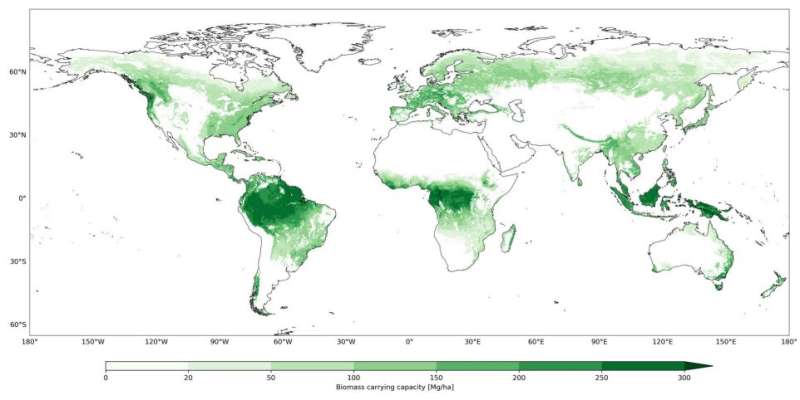Mapping and AI apps suggest ceasing management of forests not enough to offset carbon emissions
A team of atmospheric and climatic scientists from several institutions in Europe has found that even if all human management of forestry land stopped immediately, it would not be sufficient to offset global carbon emissions. In their study, reported in the journal Science, the group used mapping and AI applications to model how much forest regrowth, and by extension, sequestration of CO2, would occur under such a plan.
For several years, many large corporations have tried to mange their carbon footprint by dealing in carbon offsets and credits, paying others to engage in activities that remove CO2 from the atmosphere, theoretically, offsetting the emissions they emit. The biggest customers in such deals are those who manage large forests, such as portions of the Amazon. But there is a flaw in this system, the researchers contend—putting land back to use as forest will not be sufficient to overcome the problem of climate change.
To learn more about the impact of ceasing forest usage, including cutting and other types of forest management, the research team combined global maps depicting forestry biomass in both managed and natural forests as a means for determining current conditions. They then applied machine-learning applications to look at historical forest growth as a means for predicting new natural growth for forests around the globe.
They were able to calculate the increase in global forestry biomass that would occur if human forestry activities stopped—it came to ~44.1 petagrams of carbon. The team points out that would mean a 15% to 16% increase in carbon storage—about four years’ worth of current CO2 emissions. Thus, allowing the forests to grow back naturally would not be enough to stop the accumulation of CO2 in the atmosphere and thus, climate change.
As part of their work, the team also found that 1.6 million km2 of land would need to be reforested to compensate for just one year’s worth of CO2 emissions. Put another way, that would be a piece of land approximately the size of Alaska.
More information:
Caspar T. J. Roebroek et al, Releasing global forests from human management: How much more carbon could be stored?, Science (2023). DOI: 10.1126/science.add5878
© 2023 Science X Network
Citation:
Mapping and AI apps suggest ceasing management of forests not enough to offset carbon emissions (2023, May 19)
retrieved 19 May 2023
from https://phys.org/news/2023-05-ai-apps-ceasing-forests-offset.html
This document is subject to copyright. Apart from any fair dealing for the purpose of private study or research, no
part may be reproduced without the written permission. The content is provided for information purposes only.

A team of atmospheric and climatic scientists from several institutions in Europe has found that even if all human management of forestry land stopped immediately, it would not be sufficient to offset global carbon emissions. In their study, reported in the journal Science, the group used mapping and AI applications to model how much forest regrowth, and by extension, sequestration of CO2, would occur under such a plan.
For several years, many large corporations have tried to mange their carbon footprint by dealing in carbon offsets and credits, paying others to engage in activities that remove CO2 from the atmosphere, theoretically, offsetting the emissions they emit. The biggest customers in such deals are those who manage large forests, such as portions of the Amazon. But there is a flaw in this system, the researchers contend—putting land back to use as forest will not be sufficient to overcome the problem of climate change.
To learn more about the impact of ceasing forest usage, including cutting and other types of forest management, the research team combined global maps depicting forestry biomass in both managed and natural forests as a means for determining current conditions. They then applied machine-learning applications to look at historical forest growth as a means for predicting new natural growth for forests around the globe.
They were able to calculate the increase in global forestry biomass that would occur if human forestry activities stopped—it came to ~44.1 petagrams of carbon. The team points out that would mean a 15% to 16% increase in carbon storage—about four years’ worth of current CO2 emissions. Thus, allowing the forests to grow back naturally would not be enough to stop the accumulation of CO2 in the atmosphere and thus, climate change.
As part of their work, the team also found that 1.6 million km2 of land would need to be reforested to compensate for just one year’s worth of CO2 emissions. Put another way, that would be a piece of land approximately the size of Alaska.
More information:
Caspar T. J. Roebroek et al, Releasing global forests from human management: How much more carbon could be stored?, Science (2023). DOI: 10.1126/science.add5878
© 2023 Science X Network
Citation:
Mapping and AI apps suggest ceasing management of forests not enough to offset carbon emissions (2023, May 19)
retrieved 19 May 2023
from https://phys.org/news/2023-05-ai-apps-ceasing-forests-offset.html
This document is subject to copyright. Apart from any fair dealing for the purpose of private study or research, no
part may be reproduced without the written permission. The content is provided for information purposes only.
